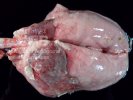Bordetelosis
Bordetella bronchiseptica is a bacterium that can cause fever or pneumonia in pigs. If there are not complications, and without the presence of toxigenic Pasteurella multocida type D, the disease has little clinical or economic consequences.
Alternative names: Bordetella bronchiseptica
Information
Bordetella bronchiseptica is a bacterium found in almost all swine populations. Some strains cause a mild and nonprogressive rhinitis and animals recover spontaneously. The disease has no clinical or economic consequences. However if toxigenic Pasteurella multocida type D is present in the farm, the combination of the two organisms can lead to a progressive atrophic rhinitis with serious economic consequences. Bordetella bronchiseptica may also be a secondary opportunistic cause of pneumonia.
Symptoms
Lactating, nursery piglets and fattening
- Conjunctivitis.
- Cough.
- Sneezes.
- Nasal discharge.
- Deformed nose (fattening).
Sows
- Deformed nose.
- Usually no clinical signs.
Causes / Contributing Factors
- A higher bacterial load may be present in an inadequate environment.
- Recirculation of air at the nursery allows the growth of the organism.
- Continued use of the building.
Diagnosis
- It is based on cultures and lab tests in conjunction with clinical signs.
- Pathogen is commonly found in nasal passages but usually not pathogenic.
Control/Prevention
- It is not necessary unless the levels are high or it is concomitant with toxigenic Pasteurella multocida type D.
- Strategic medication can be used at times.
- During elimination programs, inject pigs at weaning with long lasting antibiotics.
- Replacement animals must come from farms that are negative for atrophic rhinitis.
Atlas of pathology
See images in the Altlas related to Bordetelosis






